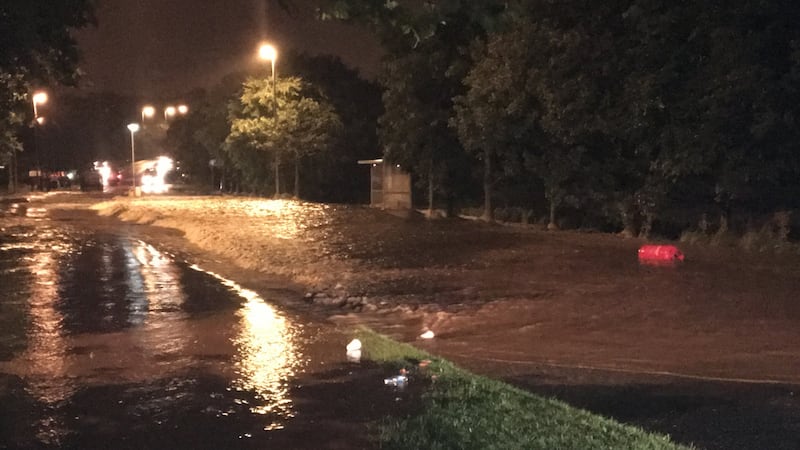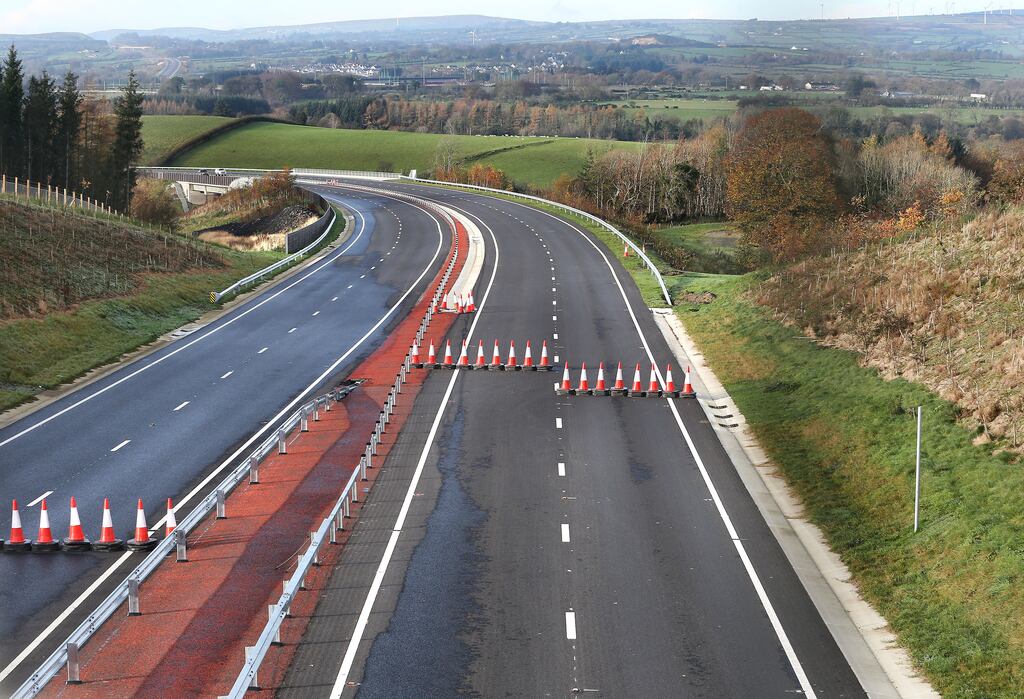Drive out of Derry on the main road to Belfast and it is only minutes before you hit the first set of roadworks.
This is the way it is now on the A6 – the road that links Northern Ireland’s two main cities, Belfast and Derry – and the way it has been for a long time, ever since works began on a project to convert the single-lane road between Drumahoe, just outside Derry, and Dungiven, some 25km away, into a dual carriageway.
The pilot study to select a route began in 2005 and the first sod was cut in 2018, but more than four years later, drivers and the people who live along the road are increasingly fed-up.
“The frustration has been just building,” says Anne Gallagher, who drives from Belfast to Derry several times a week to care for her elderly mother. “They kept saying it was going to be finished in spring, then in summer, and now they don’t even have an end date – or at least not one that I can find anywhere. I looked today when I was driving and I see side-roads not finished on the road, so you’re left to an amateur’s view, trying to guess when you think it might actually be finished.
READ MORE
“I think everyone’s at the end of their tether.”
The £220m project, which includes a bypass around Dungiven, was originally scheduled for completion this spring. That date was subsequently pushed back to “in 2022″, but has now drifted further, and it will not be completed this year.
On one recent journey, there were six sets of roadworks – including a substantial diversion along country roads – on the 60km stretch from Derry to the Castledawson roundabout, roughly halfway to Belfast, where a new dual carriageway opened last year.
Though not all the roadworks are connected to the dualling project – at least two are down to separate resurfacing works –, they add to the delays experienced by motorists and the unpredictability of driving times between these two main cities, with travelling the road more challenging, especially in the dark evenings and bad winter weather.
During a drive from Belfast to Derry in strong wind and heavy rain the week before, cones marking the way near Claudy had either been blown over or were impossible to see; one regular driver told The Irish Times he had been involved in an crash that same evening, because the traffic from the main road had got lost. “For people who aren’t familiar with it, it’s just close your eyes and hope for the best,” he says.
In Dungiven there was a brief respite during the summer, when traffic was diverted on to the new road; this has since been closed again and there have been long tailbacks as cars queue to get through the town.
Paul McCloskey, a volunteer bus driver in Dungiven, is a long-time campaigner for the A6 upgrade and the bypass. The traffic through Dungiven, he says, is back to the way it was before. “I can’t get a direct answer from the Department ... we know it’s going to be open, but we don’t know when.”
[There is the] added dimension of Derry feeling, with some justification, that it has been left behind and left isolated since the foundation of the [Northern Ireland] state right until a few years ago.
— Campaigner Eamonn McCann
In a letter from the Department of Infrastructure, dated October 26th, the schedule for the road opening is given as “within the next few months”. Reasons cited for the delay are the “huge impact” on the availability of construction materials post Covid-19, as well as the “escalating costs and delays in getting materials, including steel, timber and bitumen” and the “significant” amount of work still to be done.
In a statement the Department of Infrastructure said the Covid-19 pandemic had had a “major impact on delivery of the A6 scheme with various activities having been disrupted due to social distancing requirements, staff absences and difficulties with the supply chain” and “current market volatility” was also impacting delivery timescales.
“Despite these exceptional challenges, the department and our contractors have sought to maintain progress on this strategically important road scheme,” it said.
Though the scheme was now “well advanced”, a number of items remained to be completed, including “the provision of safety barriers, road marking, signage and street lighting” and a Road Safety Audit that “must then be completed before the road can be fully opened.
“The outcome of the audit process may recommend some safety-related amendments and therefore it is not possible to provide an exact opening date at this time,” the statement added. “It is currently envisaged that the road will open in the coming months and a firm opening date will be announced once it is known.”
Roads expert Wesley Johnston says his understanding, from talking to those involved in the project on the ground, is that “they seem to be working towards an opening date of April” for the bypass. “It is immensely frustrating,” says Johnston. “A significant amount of work does still need to be done, but it could be done a lot quicker.
“During recent flooding, the main street of Dungiven was flooded and there was a brand new road beside it, and nobody could use it, so the place was chock-a-block. As far as I can see, there’s no reason the road can’t be open.”

This undoubtedly exacerbates the frustration for motorists; that as they negotiate their way through cones at a crawl, they can see the tarmacked ribbon of the new dual carriageway empty beside them.
“Even if they reopened the bypass in one direction it would make a massive difference,” says Gallagher. “They need to manage people’s expectations, give them a date [for the opening], and in parallel with that, think about what can be done with the train service to give people another reliable option.”
The argument for an enhanced rail service to Derry – or reopening of the old line that existed to Dublin via Omagh and Dungannon – has long been made by campaigner Eamonn McCann. Today, he says, the environmental argument means the “tide has turned” away from roads and back towards the railways.
The campaign for a dual carriageway to Belfast has been long; McCann remembers “very strong agitation in the 1970s about the need for better connectivity between Derry and Belfast, or Derry and the rest of the island generally.”
[ Environmentalist loses challenge to Derry dual carriagewayOpens in new window ]
There is also the “added dimension of Derry feeling, with some justification, that it has been left behind and left isolated, literally for decades, since the foundation of the [Northern Ireland] state right until a few years ago.
“So, the agreement to build the A6 was widely seen, particularly in Derry, as an attempt to redress the balance, and the long delay has been seen by many people in Derry as ... fitting into that historical pattern.”
Even when this new section of the A6 opens, the final part of the scheme – from Drumahoe to the Caw roundabout at the Foyle Bridge in Derry – is on hold indefinitely, as is the city’s other major roads project, the upgrade of the A5, themain road from Derry to Dublin.
Long mired in legal challenges, escalating costs and a deteriorating financial situation, in 2019 a report from the Northern Ireland Audit Office estimated it was already ten years overdue and £300m over budget.

















